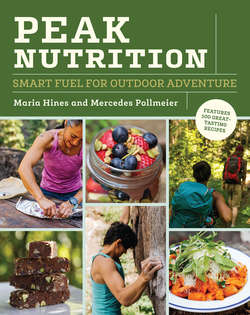Читать книгу Peak Nutrition - Maria Hines - Страница 36
На сайте Литреса книга снята с продажи.
INCREASING LONGEVITY
ОглавлениеBut it’s not all bad news. It is possible to increase your longevity. Looking at the biomarkers of aging we’ve just discussed, you can design a program to slow down the process of aging and enjoy life as you age.
Strength. One of the keys is to improve mitochondrial health, and you can do this by maintaining or increasing muscle mass to stay strong. This helps you avoid the risk of falls when you are much older. But how? Easy: Lift weights, or lift something, even yourself and heavy packs. Doing heavy lifting a few times a week is great because it increases those type IIa muscle fibers. Lift in ranges of 1 to 5 repetitions to increase strength and power and ranges of 8 to 15 repetitions to increase muscle mass. Higher numbers of reps (25 or so) can increase type I muscle fibers, which helps to increase the capacity to do more work, which equals more mitochondria.
Mobility. Continue to move and work on mobility. If your muscles are tight, your arteries are probably also stiff. Move as much as you can throughout the day. These days, sitting is the new smoking, even if you exercise regularly. Prolonged time spent seated has been shown to affect the heart and blood profiles. Blood pressure, blood glucose levels, and cholesterol and HDL levels can all be positively affected by lifting and moving regularly. Just as important, these measures are dramatically affected by diet (more on this later in this section). Doing small bouts of movement throughout the day plus your workout sessions can significantly increase your mobility and strength as well as your overall metabolism. Body fat will decrease if you lift regularly, and your bone density will improve.
RECIPES TO REDUCE INFLAMMATION
Most of our recipes in part V of the book support an anti-inflammatory diet. Favorites are:
•Wild Salmon Jerky
•Bacon Spinach Frittata Bites
•Creamy Carrot Ginger Soup
•Curry Chicken Salad
•Grilled Spatchcock Chicken with Ratatouille
Anaerobic and aerobic work. Make sure to add both anaerobic and aerobic work, such as running: sprinting is anaerobic and slow endurance is aerobic. Doing both will help maintain VO2 max and improve mitochondrial health and function. Anaerobic work could be as easy as 15 seconds of high-intensity work followed by 45 seconds of rest (repeat 8 to 10 times). Aerobic work could be a brisk walk, hike, or slow run for 30 minutes. But it all depends on what your body is currently used to. You want to do enough to maintain or improve on what you have right now, so that may mean doing more than these baseline recommendations. Once you lose your anaerobic fitness and strength, it’s tough to get it back. It’s much easier to maintain it.
Decrease stress. Increase your longevity by decreasing your stress. Life stressors and poor food choices increase oxidative stress (a buildup of free radicals) in the body and raise cortisol levels (cortisol is a hormone produced by the adrenal glands that assists the body in responding to stress, such as infections and exercise, and helps regulate blood sugar). This increase has a snowball effect at the hormonal level, resulting in inflammation. Try to take some time out of your day to reflect on how you are feeling, meditate, and do some mobility exercises. Eating a well-balanced diet with a lot of herbs and spices and doing breathing exercises can increase the antioxidant activity in the body, which basically eats up all the free radicals. These methods also help to downregulate the sympathetic nervous system (the body’s fight-or-flight response), leaving us calmer and less stressed.
